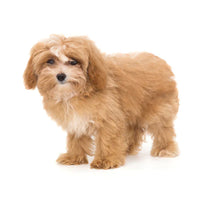Teacup Maltipoo
Lively. Cuddly. Intelligent.
- Up And Away PupsHome
- Teacup Maltipoo
- Teacup Maltipoo

Teacup Maltipoo Puppies For Sale!
If you are planning to add a new furry member to your family, then you have landed on the right page. Check out our lively and adorable Teacup Maltipoo pups. These little bundles of joy offer loads of companionship and affection. Their intelligence and liveliness will keep you entertained for hours.
Never get fooled by their miniature size! These gentle souls are ideal for your families who wish to offer comfort and snuggles. Our pups are hypoallergenic, making them perfect for those who suffer from allergies or still crave the love of a canine companion.
So, find these adorable magical pups here to experience the real joy that will bring to your life!
Breed Info
Temperament
The temperament of our Teacup Maltipoo pups is a delightful blend of alertness, affection, and energy. These small-sized pups are filled with energy and are always ready for a brisk walk or a playful romp. Their alert nature makes them the best watchdogs who are quick to notify their family about any potential intruders.
But under their lively exterior remains a heart of gold. Teacup Maltipoo pups are incredibly loving and thrive on human companionship. They are the best family pets to form strong bonds with their loved ones and are always eager to participate in family activities.
Early socialization is key for the pups since it helps them feel comfortable around small children and other animals. They showcase their protective instincts while being generally friendly with strangers and barking at unfamiliar faces. Their winning combination of alertness, love, and energy makes them the best addition to your loving home.
Appearance
The looks of the Teacup Maltipoo puppy are extremely unique and charming. The smaller stature and the square-shaped bodies make the pups exude an undeniable cuteness, melting hearts wherever they go. Their mid-length floppy ears frame their expressive faces while they are adorned with captivating or dark eyes radiating warmth and intelligence.
One of the most striking features of these little pups is their coat, which ranges from medium to long and boasts a curly to wavy texture reminiscent of softer wool. This distinctive type of coat lacks the undercoat, making them the perfect choice for those suffering from allergies. There is always a Teacup Maltipoo pup that matches every taste available in that shade of magical colors, including cream, white, cafe au lait, apricot, blue-gray, brown, silver, and black.
Despite their smaller stature, which ranges from 5 to 20 pounds and stands at around 8 to 14 inches in height, the puppies are packed with bigger personalities and ensure limitless joy in every home.
Exercise
The Teacup Maltipoo puppies are often smaller in their size as they are bigger in their enthusiasm and energy. These are the lively pups that love nothing more than exploring the best outdoors and heading out to the scopes to expend their limitless energy, whether it is a romp at a dog park or a play session in the backyard.
But it is more than physical exercises that keep them healthy and happy, with the essence of mental stimulation for these wise little pups. They will enjoy better agile exercises challenging their minds and bodies. Irrespective of their energetic nature, Teacup Maltipoos are extremely adaptable across the home environment, making them ideal for both suburban families and city dwellers.
We recommend offering them at least 40 minutes of regular activities and targeting around 5 miles of walking each week. The proper balance of mental stimulation and exercise makes your Teacup Maltipoo thrive on bringing forward limitless joy to your life.
Historic Glance of Teacup Maltipoo Puppy
Let us now take a look at the history of our adorable Teacup Maltipoo pups.
● The History of the Maltese
The highly engaging story of the Teacup Maltipoo puppy starts with their illustrious ancestors. The Maltese originate out of the Mediterranean island of Malta and trace their lineage back to their ancient times. It is the ideal blend of Spaniel and Bichon, making the breed cherishable history across different names.
These are revered through their endearing nature with Maltese dogs who seek to offer comfort to the sick. These are the charming companions who have stayed steadfast and captivated every heart to inspire the works of art and literature throughout the ages. Their endeavor in the United States in the 1700s solidified their entire status as adorable pets.
● The History of Poodles
In the meanwhile, the Teacup Maltipoo inherits qualities from their Poodle lineage. The Poodles are often tracked back to the Egyptian and Roman times, where they were known for their versatility and intelligence.
The French nobility was used in various sizes for the Poodles, ranging from truffle sniffing to duck hunting. Their quick learning abilities and intelligence made them the true performers in the circuses. Poodles have reigned as the prominent breed in America from the 1950s to the 1990s, solidifying their place in history as versatile and beloved working dogs.
Ease of Maintaining Teacup Maltipoo Puppies
It is important to maintain and care for the Teacup Maltipoo Pups.
● Grooming
It is important to keep your Teacup Maltipoo pups looking and feeling their best. Their low maintenance coats make grooming a must-have. A weekly brushing will help in retaining their medium to long hair free from any mats or tangles. Furthermore, inspect and clean their ears weekly, preventing the buildup of debris or wax.
You can use a damp cloth to wipe their ears, gently removing tear stains. Also, brush your pups' teeth a couple of times each week to help prevent dental issues.
● Training
Our Teacup Maltipoo pups are extremely intelligent and sensitive, making them a joy to train. They will respond well to positive reinforcement and praise. Also, maintain their positive tone and gentleness during the training sessions to keep your pups motivated and engaged.
Early obedience and socialization training remain key to developing good manners in your pup and getting along well with each other. Also, continue to work on the challenges and skills since they require regular mental stimulation in order to stay healthy and happy. A lot of love, consistency, and patience makes your Teacup Maltipoo pups well-adjusted and well-behaved for the upcoming times.
FAQs About Teacup Maltipoo Puppies
What Is The Average Lifespan Of A Teacup Maltipoo Puppy?
On average, Teacup Maltipoos live 12 to 15 years, though this can vary depending on factors such as genetics, diet, exercise, and overall health care. Proper nutrition, regular exercise, and routine veterinary check-ups can help ensure a long and healthy life.
Are Teacup Maltipoo Puppies Easy To Train?
Teacup Maltipoo puppies are generally quite trainable. Thanks to their intelligence and eagerness to please, they respond well to positive reinforcement methods. It's essential to start training early and maintain consistency to help them develop good manners and obedience.
Are Teacup Maltipoo Puppies Good With Family, Children, And Other Pets?
Teacup Maltipoos are known for their affectionate and gentle nature, making them excellent companions for families, including children and other pets. Early socialization and positive experiences with family members and other animals can help ensure they grow up to be well-adjusted and friendly companions.
From Where Can I Get A Cute Teacup Maltipoo Puppy?
You can find Teacup Maltipoo puppies at our renowned breeding platform, Up And Away Pups. It's crucial to research and choose a responsible breeder or adoption agency that prioritizes the health and well-being of its puppies. Contact us today to bring home your furry friend.
Are Teacup Maltipoo Puppies Hypoallergenic?
Yes, Teacup Maltipoos are considered hypoallergenic, making them suitable for people with allergies to pet dander. Their coat type, which is medium to long and lacks an undercoat, produces less dander, reducing the likelihood of triggering allergic reactions. It's essential to spend time with a Teacup Maltipoo before bringing one home if you have allergies.

























